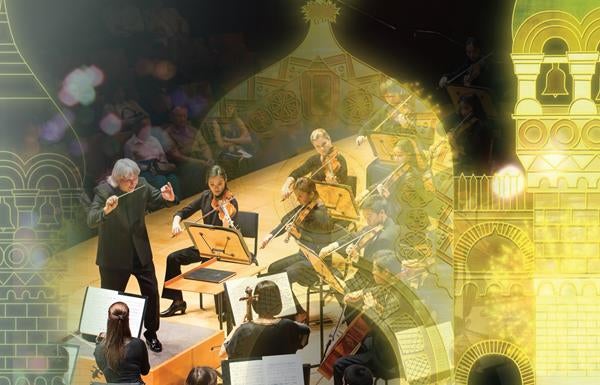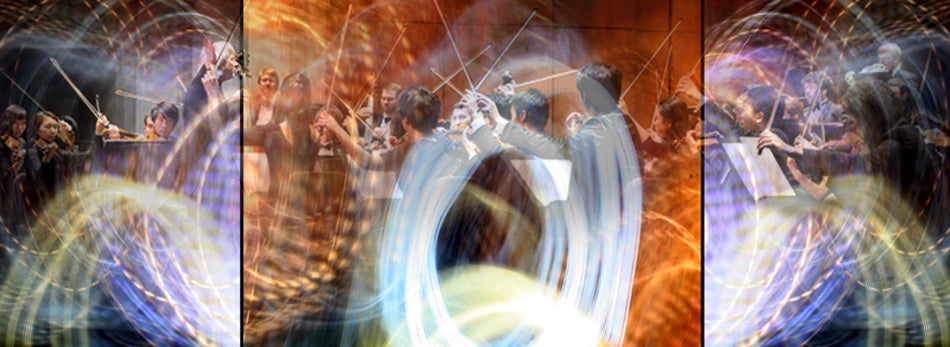 CONTACT: Evan Calbi, USC Thornton School of Music calbi@usc.edu 213/740-3229 or Allison Engel, USC Media Relations allison.engel@usc.edu 213/740-1927
CONTACT: Evan Calbi, USC Thornton School of Music calbi@usc.edu 213/740-3229 or Allison Engel, USC Media Relations allison.engel@usc.edu 213/740-1927
Live orchestral performances from the USC Thornton Symphony and conductor Carl St.Clair will be augmented with stunning multimedia images to accompany a production of Modest Mussorgsky’s Pictures at an Exhibition Sept. 12 and 13 at Santa Barbara’s Granada Theatre.
The renovated 91-year-old Spanish theater recently installed a high-definition projector to stage the production. Along with high-definition projections on a large screen, the two concerts will feature a new technology, Muséik, developed by Ion Concert Media, which allows a human operator to manipulate the multimedia visuals as the operator sits amid the orchestra’s musicians. Muséik’s developer, Ion Concert Media’s founder Scott Winters, will be “playing” the visuals from an iPad, taking cues from conductor St.Clair.
In addition to Pictures at an Exhibition, the two concerts will feature virtuosic pianist Daniel Pollack, professor of Keyboard Studies at the USC Thornton School of Music, playing Tchaikovsky’s Piano Concerto No. 1. Pollack famously performed the piece in Moscow during the legendary first International Tchaikovsky Piano Competition, where Pollack was a prizewinner along with Van Cliburn. The USC Thornton Symphony also will be performing the overture to Mikhail Glinka’s opera Ruslan and Ludmilla.
St.Clair, the artistic director of the USC Thornton Orchestra Program and music director of the Pacific Symphony, said the symphony’s opportunity to play at the Granada Theatre is a tribute to the high quality of its past performances at Disney Hall and Bovard Auditorium.
“Not every university orchestra is asked to play at venues that regularly host touring orchestras and the Santa Barbara Symphony,” he said.
Mussorgsky based Pictures at an Exhibition on paintings and drawings of the Russian artist Viktor Hartmann, a friend of Mussorgsky’s whose early death stunned the composer. In these performances, the visuals were created using a mix of 2-D and 3-D animation, illustrations, live action photography and stop-motion animation.
The work was created by USC School of Cinematic Arts’ John C. Hench Division of Animation and Digital Arts faculty members Michael Patterson and Candace Reckinger, along with 11 of their animation students and graduates. They premiered the projections in 2011 with the New World Symphony in Miami Beach, FL, as part of the celebration for that symphony’s new building. There, the projections were shown on five screens that surrounded the audience inside the concert hall.
This summer, Patterson and Reckinger, who are the creative directors of the Pictures at an Exhibition visuals, spent several weeks reconfiguring the work for a single panoramic projection. The two, who trained as mixed-media directors, said combining music and visuals can result in a rich immersive experience for the audience.

“We’re melting the borders between film, animation and music,” said Patterson. Electronic dance music VJs have been mixing visuals with live music for years, but it is relatively new for classical music, he said.
“We use the term ‘visual music,’ said Reckinger, “a field that is finally being recognized for its emphasis on the power of merging the moving image and music to create a unique experience.”
More and more concert halls are being re-conceptualized to incorporate visuals, Reckinger said. “It invites a new way to experience the music, making it more relevant to a new audience.”
The Minnesota-based Winters, who developed the software for the Muséik system in 2012, said that typically, when a film is projected with live music, the film controls the tempo. Musicians often play to click tracks, keeping time with the pace of the film. He considers his system, which can speed up or slow down the film, a musical instrument. “There’s no fingering, breathing or bowing, but it’s a musical experience,” he said. “Instead of a static 24 frames per second, we’ve turned it into a living, breathing performance,” Winters said.
The Granada Theatre is at 1214 State St. in downtown Santa Barbara. The Saturday concert begins at 8 p.m. and the Sunday concert is a matinee, beginning at 3 p.m. Tickets are available at www.granadasb.org
[Top photo montage of Carl St.Clair, the USC Thornton Symphony and Pictures at an Exhibition visuals by Ian Evenstar/USC; animation by Ria Ama. Center trio of photo montage images by Holly Wilder/USC; animation by Steven Day.]


